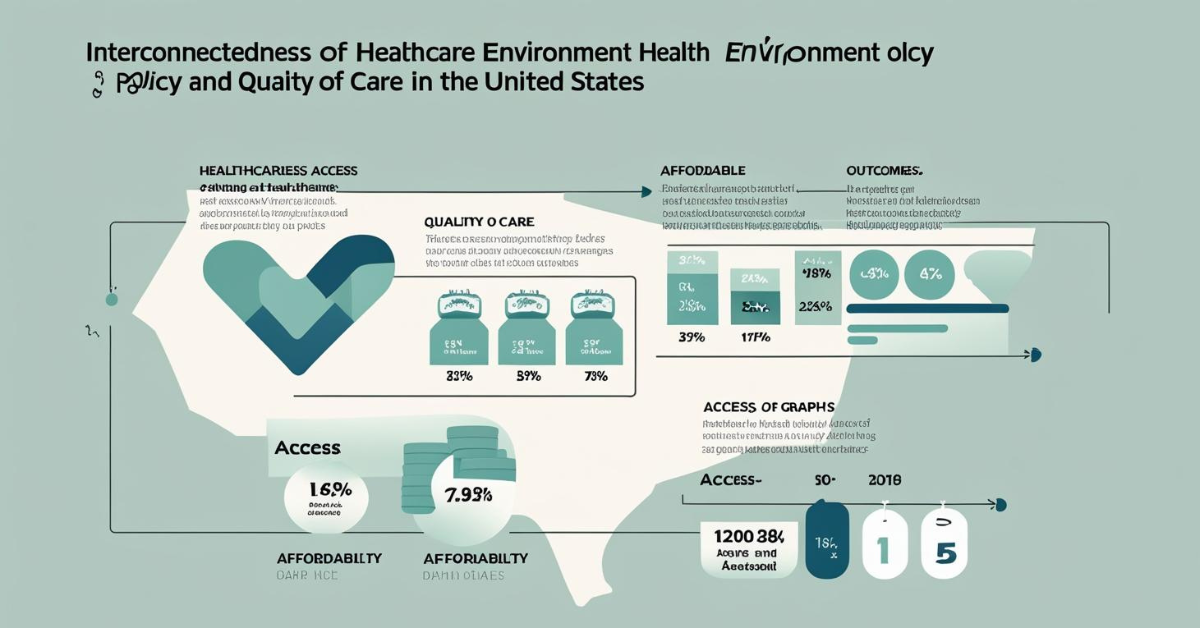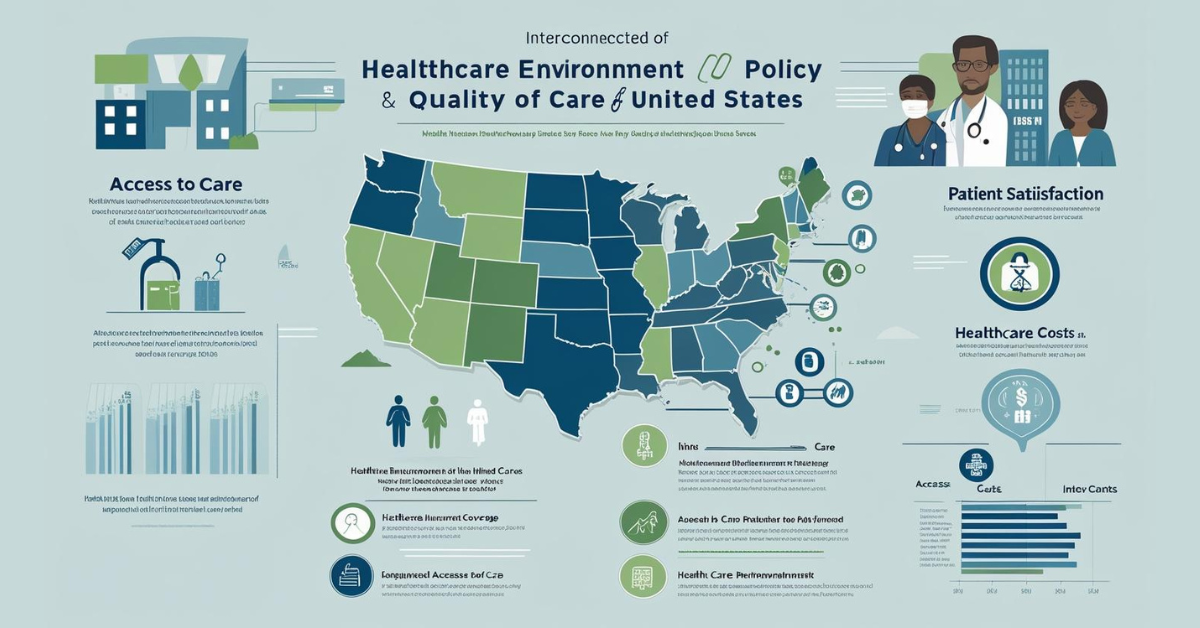The Health Care Environment Policy and Quality of Care In United State. The US spends more on healthcare than any other developed nation, but this doesn’t necessarily translate to better outcomes.
The Health Care Environment Policy and Quality of Care In United State
In the United States, the healthcare system is complex and influenced by various policies at the federal and state levels. These policies determine access to care, quality of care, and the overall healthcare environment. While the United States invests heavily in healthcare, this does not always translate into the best outcomes compared to other industrialized countries.
Insurance Coverage
The United States does not have a universal healthcare system, meaning a significant portion of the population is uninsured. Federal policies such as the Affordable Care Act (ACA) seek to expand insurance coverage, but disparities persist.
Access to Care
Insurance status is a key factor in access to care. Federal policies also designate medically underserved areas and create safety net programs to close access gaps.
Quality of Care
The quality of care is influenced by various factors, including provider training, evidence-based practices, and patient safety initiatives. Policies play an important role in setting standards and promoting quality improvements.
Health Care
The American system is characterized by a mix of public and private payers and providers. This fragmentation can lead to inefficiencies and coordination problems. Financing
Health care is financed through a combination of private insurance, public programs (Medicare and Medicaid), and out-of-pocket costs.
Policy Examples
ACA: Expanded access to health insurance, especially for low-income individuals and families.
EMTALA (Emergency Medical Treatment and Labor Act): Requires hospitals to provide emergency care regardless of health coverage and ability to pay.
HITECH Act
Promotes the adoption of electronic health records. FDA Regulations: Regulates drug development and approval.
Quality of Care
The IOM defines quality health care as “the degree to which health services for individuals and populations increase the likelihood of desired health outcomes and are consistent with current professional knowledge” (Lohr, 1990, p. 128). The AHRQ states that “quality health care means doing the right thing at the right time in the right way for the right person and having the best results possible” (1998, p. 1). Quality of care typically reflects the positive effects of health care and performance of health-care systems (Docteur & Berenson, 2009). According to the 2014 National Healthcare Quality and Disparities Report, the current National Quality Strategy has six priorities. These priorities and their current findings, as of 2014, conclude (AHRQ, 2015):
Patient safety: 50% of measures improved with a 17% reduction in hospital acquired infections
Person-centered care: Improved steadily, especially in children
Care coordination: Improved with enhanced discharge processes and health information technologies
Effective treatment: Achieved high levels of performance in hospitals, led by measures reported by the Centers for Medicare and Medicaid Services (CMS) on Hospital Compare 5. Healthy living: Improved in about 50% of measures, led by selected adolescent vaccines 6. Care affordability: Worsened from 2002 through 2010 and then leveled off Patient safety problems appear to be greater in the United States, where patients are more likely to report mistakes or adverse effects with regard to safe medication practices (Docteur & Berenson, 2009).
The United States also has “the highest rates of problems such as being given the wrong medication or dosage, experiencing a medical error, or facing delays in hearing about abnormal test results,” with rates reported as high as 34% (Docteur & Benson 2009, p. 8). Fatalities resulting from medical errors in the United States were estimated to be 98,000 per year by the IOM in 1999.
A newer, evidenced-based estimate was provided by James (2013), with a lower estimate as high as 210,000 fatalities per year and an upper estimate of premature death from medical harm as high as 400,000 per year. In addition, James stated that “serious harm seems to be 10–20 fold more common than lethal harm” (James, 2013, p. 122).
High quality implies excellent health outcomes, and there is the assumption that “Americans with good insurance coverage uniquely benefit from prompt availability and accessibility of cutting-edge medical procedures, medicines, and devices, as well as highly educated and well-trained health-care professionals, who know and consistently do what is best for their patients” (Docteur & Berenson, 2009, p. 2).
As a whole, the United States actually has an inferior quality of care compared with poorer populations. Life expectancy in the United States, which is below average when compared with that in other developed countries is among the worst performers.
The United States has “a much higher prevalence of nine of ten conditions, including cancer, heart disease, and stroke, in its population over 50” (Docteur & Berenson, 2009, p. 4). According to the Organization for Economic Co-operation and Development (OECD, 2015), in comparing the United States with other member states, “the quality of acute care in hospitals in the United States is excellent, but the U.S. health system is not performing very well in avoiding hospital admissions for people with chronic diseases.”
The OECD found that for conditions such as heart attack, stroke, and general lifesaving, the system performed well. For chronic conditions such as asthma, chronic obstructive lung disease, and diabetes, the United States fell short in areas involving patients in self-care and providing effective counseling for diet and the importance of regular exercise to moderate these chronic conditions (OECD, 2015).
Nurses at all levels need to be familiar with the safety and quality of care they provide patients and the issues associated with safe provision of nursing care. Knowledge deficits were noted by James (2013) to be a major contributor to individual and system deficiencies leading to medical errors and patient harm. These deficiencies can be rectified with comprehensive continuing education within all of the health professions (James, 2013). Nurse leaders and managers need to assist staff in attaining adequate continuing education with a focus on evidence-based practice.
Evidence-based practice and the methods by which it is implemented have only recently been included in the nursing curriculum at the baccalaureate (BSN) level. Older staff members and those educated with less than a BSN require instruction in the importance of evidence based practice and how to become involved in bringing forth policies and procedures that are evidence based. According to the AONE (2015a), clinical practice knowledge is a core competency.
Leaders and managers are responsible for demonstrating “knowledge of current nursing practice and the roles of patient care team members” (AONE, 2015a, p. 6). The following are central to leadership roles: communication of patient care standards; compliance with state nurse practice acts, as well as accreditation, regulatory, and quality agency requirements; and adherence to professional standards of nursing practice. These requirements will need to be written into policies and procedures while integrating bioethical, legal requirements (AONE, 2015a).
Read More:
https://nurseseducator.com/didactic-and-dialectic-teaching-rationale-for-team-based-learning/
https://nurseseducator.com/high-fidelity-simulation-use-in-nursing-education/
First NCLEX Exam Center In Pakistan From Lahore (Mall of Lahore) to the Global Nursing
Categories of Journals: W, X, Y and Z Category Journal In Nursing Education
AI in Healthcare Content Creation: A Double-Edged Sword and Scary
Social Links:
https://www.facebook.com/nurseseducator/
https://www.instagram.com/nurseseducator/
https://www.pinterest.com/NursesEducator/
https://www.linkedin.com/in/nurseseducator/
https://www.researchgate.net/profile/Afza-Lal-Din
https://scholar.google.com/citations?hl=en&user=F0XY9vQAAAAJ



I read this piece of writing completely regarding the comparison oof latest and preceding technologies,
it’s remarkable article. https://hallofgodsinglassi.Wordpress.com/